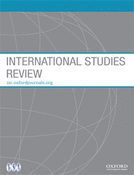-
Views
-
Cite
Cite
Cynthia Weber, From Queer to Queer IR, International Studies Review, Volume 16, Issue 4, December 2014, Pages 596–601, https://doi.org/10.1111/misr.12160
Close - Share Icon Share
Extract
What is queer? Why are queer international theories relevant to international relations? What might queer investigations of international relations look like?
While debates about the meaning of the term “queer” and whether or not queer can be or ought to be defined rage on (Butler 1994; Warner 2012; Wilcox, this forum), many self-identified queer scholars cite Eve Kosofsky Sedgwick's description of queer as their point of departure. Sedgwick suggested that queer designates “the open mesh of possibilities, gaps, overlaps, dissonances and resonances, lapses and excesses of meaning when the constituent elements of anyone's gender, of anyone's sexuality aren't made (or can't be made) to signify monolithically” (1993:8).
Sedgwick's exposition of queer makes clear the affinities queer studies has to feminist studies and gender studies—with their analyses of the political work that gender, sex, and (sometimes) sexuality do—and to poststructuralist studies—with their analyses of the political work that multiple significations do. Yet queer studies is neither reducible to feminist studies, gender studies, or poststructuralist studies. Nor is it the sum total of these theoretical dispositions. As an academic practice, queer studies has been and remains, as Teresa de Lauretis described it, an attempt “to rethink the sexual in new ways, elsewhere and other-wise” in relation to but also beyond traditional Gay and Lesbian Studies, Feminist and Gender Studies, and Poststructuralist Studies (De Lauretis 1991:xvi; Rubin 1992; Butler 1990).





